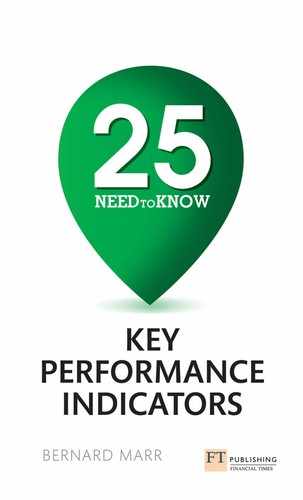Chapter 6
Revenue growth rate
- Why: To better understand your financial performance, particularly how well the business is growing
- What: To measure the growth in income a company receives
- When: When investors and managers want to understand to what extent the business is growing
- The question this indicator helps you to answer: how well are we growing the business?
Why does this KPI matter?
It is the basic fact of business that commercial organisations exist to make money. And although there are a number of factors to consider, the primary driver of ‘making money’ is to grow revenues.
Revenue (sometimes referred to as turnover or sales) is simply the income that a company receives from its normal business activ-ities, usually the sale of goods and/or services.
In accounting terms revenue represents the ‘top line’, to denote how it is reported on an income statement (at the very top). The ‘bottom line’ denotes net profit (what is left from the revenues once all expenses are deducted).
Generally, revenue might be understood as income received by an organisation in the form of cash or cash equivalents. However, sales revenue can be described as income received from selling goods or services over a given period of time.
Although revenue growth is a simple measure (in that all that is being measured is the rate of increase in the growth of revenues), its importance should not be underestimated. Growth figures are, of course, a primary focus of senior management teams, as they denote how well an organisation’s strategic and operational goals are being realised.
Moreover, growth figures are of enduring interest to the investment community. Simply put, if a company can demonstrate solid ‘top-line growth’, analysts might view this as positive, even if bottom-line growth is sluggish. It has long been recognised that consistent revenue growth is considered essential for a company’s publicly traded stock to be attractive to investors.
Analysts (and indeed senior teams and even competitors) will look at revenue growth compared to a previous period (probably a quarter or series of quarters). The current quarter’s sales figure will also usually be compared on a year-on-year basis. Such analyses provide insights into how much a company’s sales are increasing over time and therefore how well the organisation is performing, especially in comparison to the competition.
How do I measure it?
How do I collect the data?
Sales revenue data are collected from an organisation’s general ledger (the main accounting record of a business) and will be summarised periodically under the heading Revenue or Revenues on an income statement. Revenue account names describe the type of revenue, such as ‘Repair service revenue’, ‘Rent revenue earned’ or ‘Sales’.
What formula do I use?
Revenue growth is simply this quarter’s (or any other time period’s) revenue compared to that of a previous quarter (or any other time period).
How often do I measure it?
Revenues are calculated monthly and reported in the monthly management accounts. Growth rates might be reported on a quarterly basis with multi-quarter and/or year-on-year comparisons.
Where do I find the data?
This data can be extracted from the general ledger and captured in the income statement.
How difficult or costly is it to measure?
By law, organisations must capture and report revenue data, so there is no cost in collecting these data apart from the normal cost of doing business. The simplicity of calculating growth rates means that there is little cost or effort in measuring this KPI.
How do I set targets for this KPI?
For publicly traded organisations it is straightforward to compare the revenue growth of different companies (especially those in the same or similar industries/sectors), as all data are publicly available and most organisations will report growth rates (if not, they are simple to calculate).
Most commercial organisations will set growth targets as a key part of their annual budgeting process. Wherever possible, this should be based on an understanding of competitor targets.
Table 6.1 gives some example growth rates for well-known com-panies across different industries.
Table 6.1 Revenue growth rates for selected companies
| Company | Average revenue growth rates (over 5 years between 2007 and 2011) |
| Bank of America | Just over 3% |
| Walt Disney | Just over 4% |
| Wal-Mart Stores | About 5.5% |
| Colgate-Palmolive | Just under 7% |
| Exxon-Mobile | About 8.5% |
| Pfizer | Just under 10% |
| The Coca-Cola Company | About 15% |
| Apple | Over 40% |
Practical example
Revenue growth is remarkably simple to measure. For example, if Company X generated $91.3 billion in revenue during its fourth quarter of 2010 and $82.2 billion in the third quarter of that year, the company would have seen quarterly revenue growth of 11% sequentially. If Company X generated $80.2 billion in the fourth quarter of 2009, the company would have seen its revenue increase 13.8% on a year-on-year basis.
Some tips and traps to consider
Although revenue and, in particular, revenue growth is a critical measure of business performance, business success also requires attention to be paid to other financial barometers, such as expenses, as a company’s overall performance is measured by the extent to which its asset inflows (revenues) compare with its asset outflows (expenses). Net income is the result of this equation.
In start-up mode, or in entering a new market, for example, an organisation might decide to drive revenues while sacrificing net income. This is a normal business strategy. When doing so, organisations must pay close attention to cash flow, another of the key barometers of an organisation’s financial health. Healthy cash flow is critical to driving growth.
Further reading and references
CNNMoney – http://money.cnn.com
